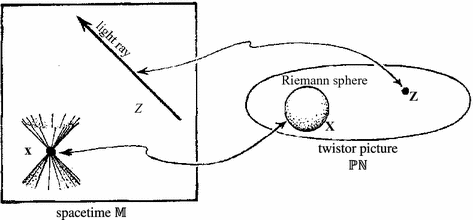My initial plan was to have the second part of these notes be about gauge symmetry and the problems physicists have encountered in handling it, but as I started writing it quickly became apparent that explaining this in any detail would take me into various issues that are quite interesting, but far afield from what I want to get to. So, I hope to get back to this at some point, but for now will just assume that most of my readers know what gauge symmetry is, and that the rest just need to know that:
The actual situation is quite a bit more complicated than this, but for now we’ll focus on the simplest version of the mathematical problem that comes up here, and see how the BRST formalism deals with it. This posting will begin explaining one part of this story, starting with the simplest version of BRST cohomology, in a language familiar to physicists. The next posting will deal with Lie algebra cohomology in a more general mathematical context and work out some examples. For more about the material in this posting, see, for instance, Green, Schwarz and Witten, volume I, section 3.2.1, where they go on to apply this to the Virasoro algebra, or these lecture notes from Jose O’Figueroa-Farrill .
Physicists always begin by choosing a basis, in this case a basis [tex]X_i[/tex] of [tex]\mathfrak g[/tex] satisfying [tex][X_i,X_j]=f_{ij}^kX_k[/tex], where [tex]f_{ij}^k[/tex] are called the structure constants of [tex]\mathfrak g[/tex]. A representation [tex](\pi,V)[/tex] is then a set of linear operators [tex]K_i=\pi (X_i)[/tex] on [tex]V[/tex] satisfying [tex][K_i,K_j]=f_{ij}^kK_k[/tex]. Let [tex]\alpha^i[/tex] be a basis of the dual space [tex]\mathfrak g^*[/tex], dual to the basis [tex]X_i[/tex].
Now, extend [tex]V[/tex] to [tex]\mathcal =V\otimes \Lambda^* (\mathfrak g^*)[/tex], where [tex]\Lambda^* (\mathfrak g^*)[/tex] is the exterior algebra on [tex]\mathfrak g^*[/tex]. On this space, define the “ghost” operator [tex]c^i[/tex] to be wedge-product with [tex]\alpha^i[/tex], and “anti-ghost” operator [tex]b_i[/tex] to be contraction (interior product) with [tex]X_i[/tex]. These operators satisfy “fermionic” anti-commutation relations
[tex]\{c^i,c^j\}=\{b_i,b_j\}=0,\ \ \{c^i,b_j\}=\delta^i_j[/tex]
and one can get all vectors in [tex]\mathcal H[/tex] from linear combinations of decomposable elements of [tex]\mathcal H[/tex] (those given by repeated application of the [tex]c^i[/tex] to the “vacuum vector” [tex]V\otimes \mathbf 1[/tex]).
The ghost number operator [tex]N=c^ib_i[/tex] on [tex]\mathcal H[/tex] has eigenvectors the decomposable elements, with integer eigenvalues from 0 to dim [tex]\mathfrak g[/tex], given by the number of ghost operators needed to produce the eigenvector from a vacuum vector.
The BRST operator is given by
[tex]Q=c^iK_i -\frac{1}{2}f_{ij}^kc^ic^jb_k[/tex]
which increases the ghost number by one, and has the crucial property of [tex]Q^2=0[/tex] (this comes from the fact that the [tex]f_{ij}^k[/tex] satisfy the Jacobi identity). The BRST cohomology is given by considering the space [tex]ker\ Q[/tex] of elements [tex]\chi[/tex] of [tex]\mathcal H[/tex] that are “BRST-closed”, i.e. satisfy [tex]Q\chi=0[/tex], and identifying two such elements if they are “BRST-exact”, i.e. differ by [tex]Q\lambda[/tex] for some [tex]\lambda[/tex]. So BRST cohomology is defined by
[tex]H^*_Q(V)=\frac{ker\ Q}{im\ Q}|_{V\otimes\Lambda^*(\mathfrak g^*)[/tex]
with [tex]H^j_Q(V)[/tex] the component of the BRST cohomology of ghost number [tex]j[/tex].
A vector [tex]\chi=v\otimes\mathbf 1[/tex] of ghost number zero satisfies [tex]Q\chi =0[/tex] iff and only if [tex]K_iv=0[/tex] for all i, so we can identify [tex]H^0_Q(V)[/tex] with the space [tex]V^\mathfrak g[/tex] of [tex]\mathfrak g[/tex] – invariant vectors in [tex]V[/tex].
The essence of the BRST method is to replace the problem of finding the invariant subspace [tex]V^{\mathfrak g}[/tex] of a representation [tex]V[/tex] by the problem of finding the degree zero BRST cohomology [tex]H^0_Q(V)[/tex].
There are two different ways of putting an inner product on [tex]\Lambda^*(\mathfrak g*)[/tex] and thus getting an inner product on [tex]\mathcal H[/tex] ([tex](\pi,V)[/tex] is assumed to be unitary, so preserves a given inner product on [tex]V[/tex]).
[tex]< \omega_1,\omega_2> = \int \omega_1\omega_2\equiv coeff.\ of\ \alpha_1\wedge\cdots\wedge\alpha_{dim\ \mathfrak g}\ in\ \omega_1\wedge\omega_2[/tex]
(this uses the “fermionic” or “Berezin” integral [tex]\int[/tex], although I have not properly dealt with signs here. ).
This inner product is indefinite, but it makes the BRST operator [tex]Q[/tex] and ghost-operator [tex]c^i[/tex] self-adjoint.
[tex]< \omega_1,\omega_2> = \int_G \omega_1\wedge *_{Hodge} \omega_2[/tex]
(Note, here the integral sign is not Berezin integration, but the usual integration of differential forms over a compact manifold, in this case [tex]G[/tex])
With this inner product [tex]Q[/tex] and [tex]c^i[/tex] are not self-adjoint on [tex]\mathcal H[/tex]. To get something self-adjoint, one can consider the operator [tex]Q + Q^\dagger[/tex] where [tex]Q^\dagger[/tex] is the adjoint of [tex]Q[/tex], but this operator does not have a definite ghost-number.


